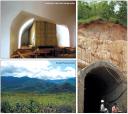Well, the Washington Post offers an update on how the money is being moved and even highlights the story of a defector who claims to be involved in the DPRK’s insurance racket:
For Kim Jong Il’s birthday, North Korean insurance managers prepared a special gift.
In Singapore, they stuffed $20 million in cash into two heavy-duty bags and sent them, via Beijing, to their leader in Pyongyang, said Kim Kwang Jin, who worked as a manager for Korea National Insurance Corp., a state-owned monopoly.
Kim said he helped arrange the shipment and watched in February 2003 as the cash was packed. After the money arrived, Kim Jong Il sent a letter of thanks to the managers and arranged for some of them to receive gifts that included oranges, apples, DVD players and blankets, Kim said.
“It was a great celebration,” he said.
The $20 million birthday present and the gratitude of its recipient, who is known as the Dear Leader, were annual highlights of a sophisticated global insurance fraud that North Korea has concocted to provide its communist leadership with hard currency, said Kim, who spent five years as an executive of the state insurance company in Pyongyang and worked for a year at its banking subsidiary in Singapore before defecting to South Korea.
The British court ruled the way it did [NKeconWatch: this might be an error as the court did not rule on the case–it was settled] because the reinsurance companies contractually agreed to be bound by the North Korean court system (which to nobody’s surprise systematically rules in favor of domestic agencies and firms). Since the western reinsurance firms could not prove that the DPRK was committing fraud, they had to pay up.
And how does this program work?
While working for North Korea’s insurance monopoly, Kim Kwang Jin said, he and other managers had a tightly focused mission: to find reinsurance companies and brokers in different parts of the world who would accept high premiums to reinsure KNIC’s policies.
Those policies, he said, usually covered losses from common North Korean disasters such as mining accidents, industrial fires, transportation crashes and crop losses due to floods.
“The major point of the reinsurance operation is that they are banking on disaster,” he said. “Whenever there is a disaster, it becomes a source of hard currency.”
According to Kim, KNIC would target a different potential disaster and a different reinsurance company each year. “We pass it around,” he said. “One year, it might be Lloyd’s; the next year, it might be Swiss Re; and the next, Munich Re.”
In London, the expert on the insurance industry familiar with the helicopter case echoed Kim’s assessment of how KNIC operated. He spoke on the condition of anonymity because he was not authorized by reinsurers to talk about the case.
“They pay good premiums, and they are very sophisticated, very clever,” he said. “They would divvy business up into very small bites and use different brokers in different places. The division of losses was such that it would never be apparent to a prospective reinsurer just how bad the business was.”
The North Koreans were known in the reinsurance industry for their capacity to prepare meticulously documented claims, speed them through puppet courts in Pyongyang and demand quick payment from international reinsurers. The North sometimes restricts the ability of reinsurers to dispatch investigators to verify claims.
The North Korean insurance monopoly sometimes took advantage of the geographical and political ignorance of brokers and reinsurers, according to the London-based insurance expert. Some brokers and companies, he said, thought they were dealing with a company from South Korea, while others were unaware that North Korea is a secretive totalitarian state with one of the world’s worst human rights records.
…
When he worked at KNIC, Kim said, annual revenue from North Korea’s reinsurance claims was about $50 million to $60 million. Most of that money, he said, was used to scout out potential disasters inside North Korea, to buy more reinsurance on the global market and to pay premiums.
“The remaining hard currency should have been used to help people recover from disasters and accidents, but it was not used that way,” Kim said. “It is just going into the pocket of Kim Jong Il.”
He said cash shipments of $20 million arrived yearly in Pyongyang, usually in the week before Feb. 16, which is Kim Jong Il’s birthday and a national holiday. In his six years at KNIC, Kim said, bags of cash arrived in Pyongyang from Singapore, Switzerland, France and Austria.
The money, he added, was delivered to an entity called Bureau 39 of the Korean Workers’ Party Central Committee. It was created by Kim Jong Il in the 1970s to collect hard currency and give him an independent power base, according to defectors, Seoul-based analysts and published reports. These sources agree that Bureau 39 spends foreign currency on luxury goods for the North Korean elite, components for missiles and other weapons programs.
With Bureau 39 skimming off hard-currency earnings returned to North Korea by KNIC’s global operation, Kim said, claims to disaster victims had to be paid in won, North Korea’s currency.
“That money is nearly worthless at present, because the economy has collapsed,” he said. “This means that little is done to help people recover from fires or whatever.”
But Kim Jong Il has been pleased with the state insurance company, Kim said.
“It brings him large amounts of hard currency,” Kim said. “Working in insurance is one of the best professions in North Korea. Many people want to do it.”
Mr. Kim is working in the Washington DC area this year with the Committee for Human Rights in North Korea.
Read the full artocle here:
Global Insurance Fraud By North Korea Outlined
Washington Post
Blane Harden
6/18/2009

